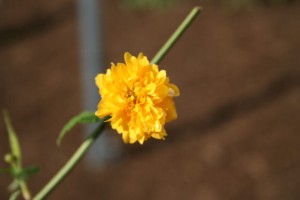 |
| What would you call this? It’s a Kerria japonica – but goes by other names. |
Plants have names, just like people. They have a proper name called a botanical name, and a nickname called a common name. When you shop for plants or ask someone for advice about them, it helps to know the botanic name. Why? Because common names can vary – sometimes a lot. Your family may call the plant by one name, my family may call it something else. Understanding the scientific classification of plants, or the botanical names, is a very important aspect of gardening, but one that confuses most beginners.
Kerria japonica, for instance, is the botanical name for a shrub from Japan and Asia in the rose family; my family called it the Bee Bush because we never knew the true name for the shrub that bloomed in the corner of the yard each year in my childhood home. My husband calls our Kerria plant “the Joan bush” because our friend Joan gave us the plant. Someone saw my pictures on Facebook and said, “Oh, that’s a yellow rose.” You see how confusing it can get?
Fortunately, we have botanical names. Thank you, Carl Linnaeus – he invented the scientific classification system.
If you’d like to learn more about how to understand the system of botanic names for plants, I’ve written an article on HubPages called Understanding the Scientific Classification of Plants that may be helpful.




